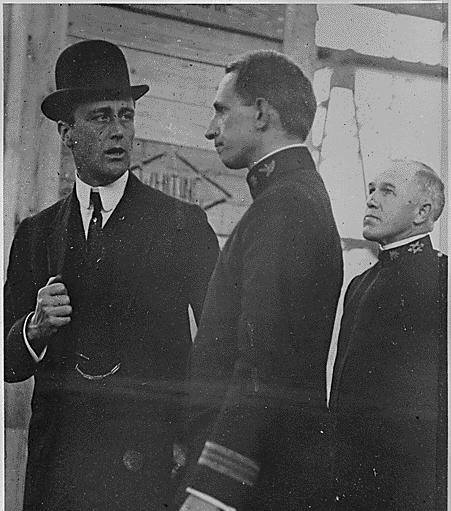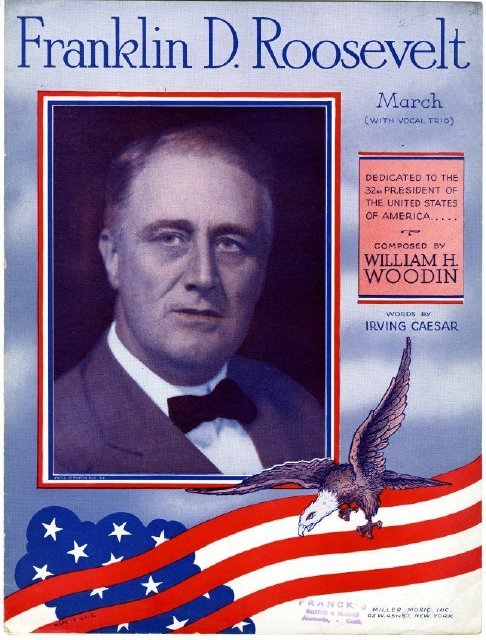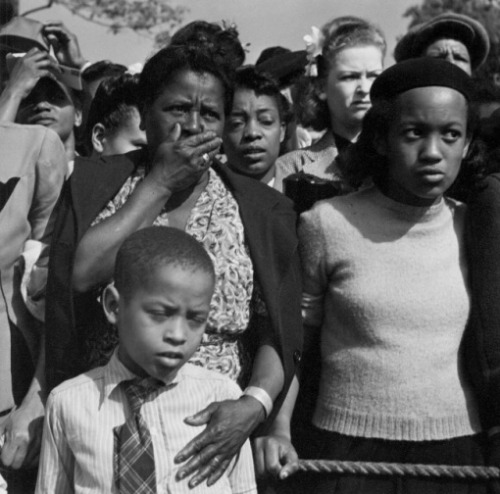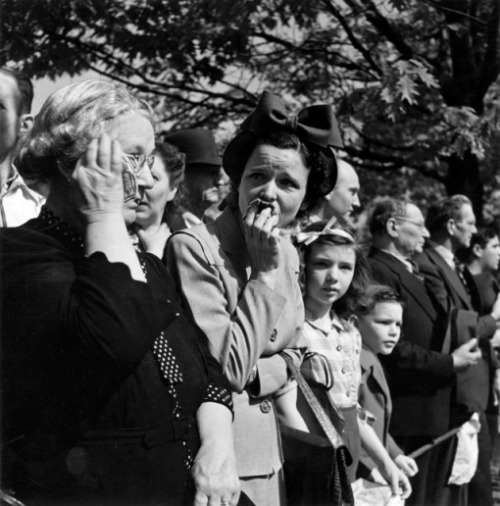#franklin d roosevelt
Franklin D. Roosevelt, Assistant Secretary of the U.S. Navy, at the Philadelphia Navy Yard, October, 1917
Post link
May 6, 1935 – FDR creates Works Progress Administration (WPA)
“On this day in 1935, President Franklin D. Roosevelt signs an executive order creating the Works Progress Administration (WPA). The WPA was just one of many Great Depression relief programs created under the auspices of the Emergency Relief Appropriations Act, which Roosevelt had signed the month before. The WPA, the Public Works Administration (PWA) and other federal assistance programs put unemployed Americans to work in return for temporary financial assistance. Out of the 10 million jobless men in the United States in 1935, 3 million were helped by WPA jobs alone.While FDR believed in the elementary principles of justice and fairness, he also expressed disdain for doling out welfare to otherwise able workers. So, in return for monetary aid, WPA workers built highways, schools, hospitals, airports and playgrounds. They restored theaters–such as the Dock Street Theater in Charleston, S.C.–and built the ski lodge at Oregon’s Mt. Hood. The WPA also put actors, writers and other creative arts professionals back to work by sponsoring federally funded plays, art projects, such as murals on public buildings, and literary publications. FDR safeguarded private enterprise from competition with WPA projects by including a provision in the act that placed wage and price controls on federally funded products or services.Opponents of the New Deal in Congress gradually pared back WPA appropriations in the years leading up to World War II. By 1940, the economy was roaring back to life with a surge in defense-industry production and, in 1943, Congress suspended many of the programs under the ERA Act, including the WPA.“|
-History.com
This week in History:
May 3, 1952 First aircraft lands at North Pole
May 4, 1965 Willie Mays breaks National League home run record
May 5, 1961 Alan Shepard becomes first American in space
May 6, 1940 John Steinbeck wins Pulitzer for The Grapes of Wrath
May 7, 1994 Munch’s The Scream recovered after theft
May 8, 1945 V-E Day is celebrated in America and Britain
May 9, 1914 Woodrow Wilson proclaims first Mother’s Day holiday
Thisprint by Paul Kucharyson can be found in the online collection of The Columbus Museum.
Post link
March 4, 1933: FDR inaugurated
“On March 4, 1933, at the height of the Great Depression, Franklin Delano Roosevelt is inaugurated as the 32nd president of the United States. In his famous inaugural address, delivered outside the east wing of the U.S. Capitol, Roosevelt outlined his “New Deal”–an expansion of the federal government as an instrument of employment opportunity and welfare–and told Americans that “the only thing we have to fear is fear itself.” Although it was a rainy day in Washington, and gusts of rain blew over Roosevelt as he spoke, he delivered a speech that radiated optimism and competence, and a broad majority of Americans united behind their new president and his radical economic proposals to lead the nation out of the Great Depression.
Born into an upper-class family in Hyde Park, New York, in 1882, Roosevelt was the fifth cousin of Theodore Roosevelt, who served as the 26th U.S. president from 1901 to 1909. In 1905, Franklin Roosevelt, who was at the time a student at Columbia University Law School, married Anna Eleanor Roosevelt, the niece of Theodore Roosevelt. After three years as a lawyer, he decided to follow his cousin Theodore’s lead and sought public office, winning election to the New York State Senate in 1910 as a Democrat. He soon won a reputation as a charismatic politician dedicated to social and economic reform.
Roosevelt supported the progressive New Jersey governor Woodrow Wilson in his bid for the Democratic presidential nomination, and after Wilson’s election in 1912 Roosevelt was appointed assistant secretary of the U.S. Navy, a post that Theodore Roosevelt once held. In 1920, Roosevelt, who had proved himself a gifted administrator, won the Democratic nomination for vice president on a ticket with James Cox. The Democrats lost in a landslide to Republicans Warren Harding and Calvin Coolidge, and Roosevelt returned to his law practice and undertook several business ventures.
In 1921, he was stricken with poliomyelitis, the virus that causes the crippling disease of polio. He spent several years recovering from what was at first nearly total paralysis, and his wife, Eleanor, kept his name alive in Democratic circles. He never fully recovered and was forced to use braces or a wheelchair to move around for the rest of his life.
In 1924, Roosevelt returned to politics when he nominated New York Governor Alfred E. Smith for the presidency with a rousing speech at the Democratic National Convention. In 1928, he again nominated Smith, and the outgoing New York governor urged Roosevelt to run for his gubernatorial seat. Roosevelt campaigned across the state by automobile and was elected even as the state voted for Republican Herbert Hoover in the presidential election.
As governor, Roosevelt worked for tax relief for farmers and in 1930 won a resounding electoral victory just as the economic recession brought on by the October 1929 stock market crash was turning into a major depression. During his second term, Governor Roosevelt mobilized the state government to play an active role in providing relief and spurring economic recovery. His aggressive approach to the economic crisis, coupled with his obvious political abilities, gave him the Democratic presidential nomination in 1932.
Roosevelt had no trouble defeating President Herbert Hoover, who many blamed for the Depression, and the governor carried all but six states. During the next four months, the economy continued to decline, and when Roosevelt took office on March 4, 1933, most banks were closed, farms were suffering, 13 million workers were unemployed, and industrial production stood at just over half its 1929 level.
Aided by a Democratic Congress, Roosevelt took prompt, decisive action, and most of his New Deal proposals, such as the Agricultural Adjustment Act, National Industrial Recovery Act, and creation of the Public Works Administration and Tennessee Valley Authority, were approved within his first 100 days in office. Although criticized by many in the business community, Roosevelt’s progressive legislation improved America’s economic climate, and in 1936 he easily won reelection.
During his second term, he became increasingly concerned with German and Japanese aggression and so began a long campaign to awaken America from its isolationist slumber. In 1940, with World War II raging in Europe and the Pacific, Roosevelt agreed to run for an unprecedented third term. Reelected by Americans who valued his strong leadership, he proved a highly effective commander in chief after the December 1941 U.S. entrance into the war. Under Roosevelt’s guidance, America became, in his own words, the “great arsenal of democracy” and succeeded in shifting the balance of power in World War II firmly in the Allies’ favor. In 1944, with the war not yet won, he was reelected to a fourth term.
Three months after his inauguration, while resting at his retreat at Warm Springs, Georgia, Roosevelt died of a massive cerebral hemorrhage at the age of 63. Following a solemn parade of his coffin through the streets of the nation’s capital, his body was buried in a family plot in Hyde Park. Millions of Americans mourned the death of the man who led the United States through two of the greatest crises of the 20th century: the Great Depression and World War II. Roosevelt’s unparalleled 13 years as president led to the passing of the 22nd Amendment to the U.S. Constitution, which limited future presidents to a maximum of two consecutive elected terms in office.”
This week in History:
March 1, 1961 - Peace Corps established
March 2, 1904 - Dr. Seuss born
March 3, 1931 - “The Star-Spangled Banner” becomes official national anthem
March 4, 1861 - Abraham Lincoln inaugurated
March 5, 1963 - Hula-Hoop patented
March 6, 1820 - Monroe signs the Missouri Compromise
March 7, 1876 - Alexander Graham Bell patents the telephone
This sheet of music of the Franklin D. Roosevelt March (played at his inauguration) can be found in the online collection of the Kentucky Historical Society.
Post link

Franklin Delano Roosevelt, 32nd US President
I’m proud of this one. I sculpted a suited doll to sit in a wheelchair and gave it a tumbler of scotch.
I can only make this once, so order while you can! Available now at my Etsy.
@Kyle_MacLachlan as President Franklin D. Roosevelt in the tv series Atlantic Crossing.
#PresidentsDay
Post link
Artifact Road Trip - Massachusetts

Barns North Franklin, Mass.
By Lester Burbank Bridaham. This print was created for the Massachusetts Art Project, Federal Art Project, Works Progress Administration.
Find out more about this #ArtifactRoadTrip engraving on our Digital Artifact Collection: https://fdr.artifacts.archives.gov/objects/11504
Follow along each week as we feature a different artifact in our Museum Collection from each of the United States.





In 1919 as Assistant Secretary to the Navy, Franklin D. Roosevelt visited the battlefields in Europe. During that trip he took these gravesite photos in Belgium and France. Today we remember those who made the ultimate sacrifice, those who put on the uniform and did not come back.
Artifact Road Trip - Maine
 ALT
ALTA painting of the destroyer, USS ANDERSON, on patrol in Tenants Harbor, St. George, Maine, by Edwin Whitman. Commissioned in May 1939, the USS ANDERSON (DD-411), a Sims-class U.S. Navy destroyer, was named for Rear Admiral Edwin Alexander Anderson, Jr. The ship served in both the Atlantic and Pacific during WWII before being decommissioned in August 1946.
Find out more about this #ArtifactRoadTrip painting on our Digital Artifact Collection: https://fdr.artifacts.archives.gov/objects/29540
Follow along each week as we feature a different artifact in our Museum Collection from each of the United States.

Artifact Road Trip - Louisiana
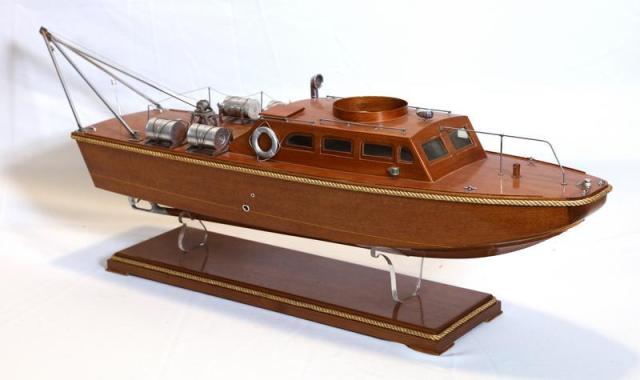 ALT
ALTA scale model of a fully equipped Patrol Torpedo (PT) boat. These boats were manufactured in large numbers during World War II by Higgins Industries of Louisiana. In October 1942, FDR visited a New Orleans factory operated by Higgins Industries. Company founder and president, Andrew Jackson Higgins, later gave Roosevelt this model of a Higgins PT boat on October 6, 1943.
Find out more about this #ArtifactRoadTrip model on our Digital Artifact Collection: https://fdr.artifacts.archives.gov/objects/2711
Follow along each week as we feature a different artifact in our Museum Collection from each of the United States.

“Mapping the New Deal”:
A Conversation with Richard Walker
Live, virtual program
Date: Wednesday, May 11, 2022, EDT
Time: 2:00 p.m. EDT
Link:https://youtu.be/KfULhsnpqtI
On Wednesday, May 11, 2022, at 2:00 p.m. EDT, the Roosevelt Library will present “Mapping the New Deal”: A Conversation with Richard Walker. FDR Library Acting Director William Harris will lead the discussion with Richard Walker, the Director of the Living New Deal Project. This live, virtual event will be streamed to the Library’s official YouTube, Facebook and Twitter accounts. Q&A in the comments/chat following the presentation.
The mission of the Living New Deal is three-fold: research, presentation and education. It begins with the historical work of uncovering the immense riches of New Deal public works. That research is then made available to all through digital mapping (livingnewdeal.org/map) and a website that serves as a clearinghouse for information on the New Deal. And, finally, the information gained from their work is disseminated as widely as possible through newsletters, social media, written media, interviews, lectures and other public events. For information visitlivingnewdeal.org.
Lend-Lease Act

65-694(4): American workers prepare a Lend-Lease food shipment, August 1942.
Despite opposition, on March 8, 1941, HR 1776, the Lend-Lease Act (subtitled “An Act to Promote the Defense of the United States”), passed through a final vote in the Senate. On March 11 the president signed it into law.
Learn more on our website: https://fdrlibrary.org/lend-lease
Artifact Road Trip - Kentucky
 ALT
ALTDuring his far-flung wartime inspection tours, President Roosevelt often received models and other gifts from workers and staff in defense factories and military facilities. During the President’s April 30, 1943 inspection tour of Kentucky’s Fort Knox, Master Sergeant Ivan H. Howitz, gave FDR this model tank— a visual aid used at the base’s Armored Force School.
Find out more about this #ArtifactRoadTrip model on our Digital Artifact Collection: https://fdr.artifacts.archives.gov/objects/2546
Follow along each week as we feature a different artifact in our Museum Collection from each of the United States.

Artifact Road Trip - Indiana


This carving was sent to Franklin D. Roosevelt in 1937 by the maker, Henry Weber of Oakville, Indiana. The white oak tree, from which the wood for the piece was taken, stood beside the trail leading from Abraham Lincoln’s cabin to the cemetery - and near the grave - of Lincoln’s mother, Nancy Hanks Lincoln, in Spencer County, Indiana. When the tree died in 1933, it was estimated to be 350 years old. The stump was shipped to Weber by his son, Horace S. Weber, a member of the Civilian Conservation Corps (CCC).
Find out more about this #ArtifactRoadTrip carving on our Digital Artifact Collection: https://fdr.artifacts.archives.gov/objects/627
Follow along each week as we feature a different artifact in our Museum Collection from each of the United States.

More than a Moment for the Nation: The Presidential Funeral of FDR
The honored guest was Franklin Delano Roosevelt, President of the United States. He had returned home to Springwood, his estate in Hyde Park, NY, to be laid to rest.
Read “More than a Moment for the Nation: The Presidential Funeral of FDR” on our blog.
Artifact Road Trip - Michigan
 ALT
ALTThis statuette of a clipped poodle by Detroit artist Walter Edward Speck was made for the Michigan Art Project, Federal Art Project, Works Progress Administration.
Find out more about this #ArtifactRoadTrip sculpture on our Digital Artifact Collection: https://fdr.artifacts.archives.gov/objects/29357
Follow along each week as we feature a different artifact in our Museum Collection from each of the United States.

#AtHomeWithTheRoosevelts Conversations: Presidential Transitions
At Home with the Roosevelt Live - Encore Presentation:
A conversation between the former Franklin D. Roosevelt Library Director Paul Sparrow and the Harry S. Truman Library Director Kurt Graham on the April 12, 1945 presidential transition between the Roosevelt and Truman administrations.
REMEMBERING FDR
FDR’s death shocked the nation. Millions of American never forgot where they were and what they felt when they learned the news. Many reflected on how deeply his presidency had impacted their lives.
In 2005, the Franklin D. Roosevelt Presidential Library and Museum asked a group of Americans to talk about their memories of FDR’s death and reflect on his legacy. This program features excerpts from their recorded remarks.
This film, “Remembering FDR,” is also featured in the current exhibition “FDR’s Final Campaign” open now.
To keep updated on our At Home with the Roosevelts programs, subscribe bi-weekly E-Newsletter - https://lp.constantcontactpages.com/su/mwZHCz3/athomepage
FDR’s Last Days
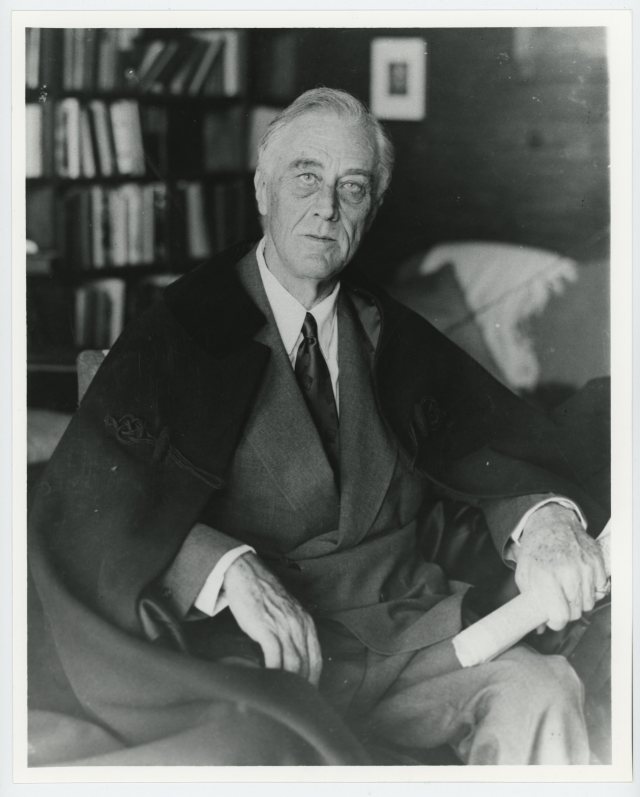 ALT
ALT ALT
ALTFDR’s last days were spent quietly at Warm Springs. The President sat for a portrait by artist Elizabeth Shoumatoff and conversed casually with his guests. On April 10 and 11, Shoumatoff’s assistant made a series of photographs of the President to assist her with her painting. They last images ever shot of him.
On April 10, FDR and Lucy Rutherfurd took a leisurely drive to Dowdell’s Knob, a rocky outcrop that offered a broad view of the surrounding countryside. Roosevelt had visited it many times during the difficult early years of his struggle with polio. It remained a favorite place to sit and reflect.
International issues still forced their way into the secluded world of the Little White House. Soviet actions in Eastern Europe threatened to divide the Allies just as victory was in sight in Europe. Seeking to maintain the alliance and ensure the success of the UN conference in San Francisco, FDR worked to smooth the waters. “I would minimize the Soviet problem as much as possible,” he wrote to Winston Churchill on the morning of April 11, “We must be firm, however, and our course thus far is correct.“ Later that dictated a speech he was to make on April 13. That evening, he dined with his Treasury Secretary Henry Morgenthau, Jr. Morgenthau was shocked by his old friend’s haggard appearance. Before he departed that night, FDR told him about his upcoming trip to the UN conference. He would appear there in his wheelchair, he told Morgenthau.
—
 ALT
ALT ALT
ALT ALT
ALTThese five photographs, shot on April 10-11, 1945, are the last images of President Roosevelt ever taken. They reveal the dire state of his health. The photographs were made by Nicholas Robbins, an assistant to artist Elizabeth Shoumatoff. Shoumatoff came to Warm Springs in April to paint a portrait of the President. She instructed Robbins take these photos to help her complete the portrait at her studio.
The three photographs of FDR outside his Warm Springs cottage were shot on April 10. The other two shots—taken inside the cottage—were made on April 11.
See these photographs and more in our current exhibition "FDR’s Final Campaign”.
Opening Day
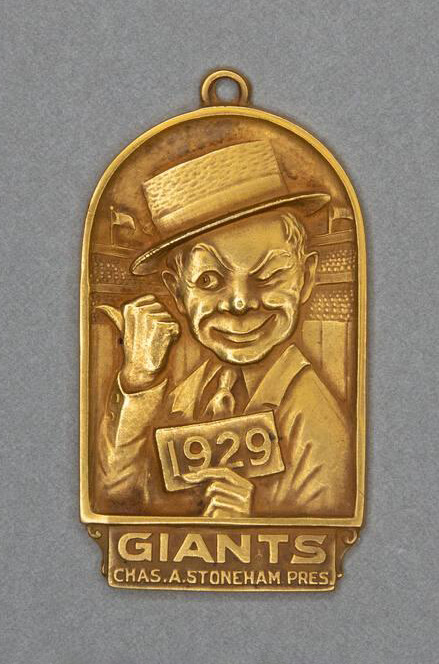 ALT
ALTFrom 1919 to 1931 (with the exception of 1928) the New York Giants issued special passes, mainly made of sterling silver, to season ticket holders and select dignitaries. The passes, manufactured by Lambert Bros. of New York, were designed in a variety of shapes and baseball motifs and included the pass holder’s name on the reverse. The passes entitled the bearers to admission to every Giants game played at the Polo Grounds during a particular season.
This 1929 New York Giants gold pass was issued to New York State Governor Franklin D. Roosevelt.
See more passes on our Digital Artifact Collection: https://fdr.artifacts.archives.gov/search/%22new%20york%20giants%22
WARM SPRINGS, APRIL 1945
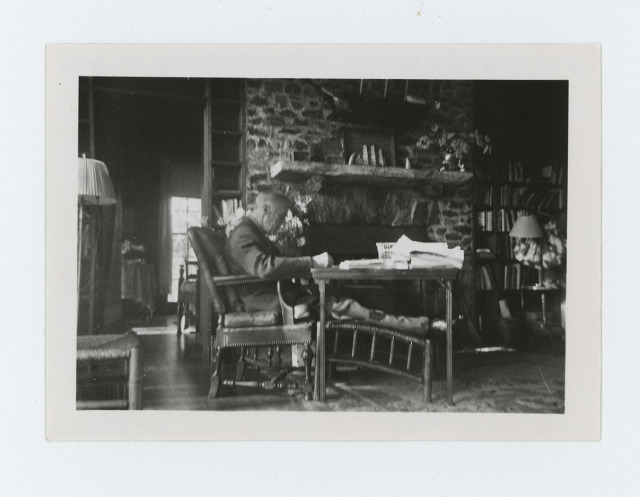 ALT
ALTPresident Roosevelt spent most of March at the White House and his Park estate. During these weeks he laid plans for the April conference Francisco that would draft a charter for the United Nations organization President took particular care to assemble a bipartisan U.S. delegation conference. These efforts were complicated by growing concerns about Soviet behavior in Eastern Europe, where Stalin was ignoring agreements at Yalta. Winston Churchill pushed Roosevelt to take a more confrontational approach with Stalin, but FDR counseled patience. He did not want to jeopardize Soviet participation in the United Nations, believing it offered the best hope for curbing Stalin’s bad behavior.
On March 29, a weary President departed Washington for a vacation in Warm Springs, Georgia. Eleanor Roosevelt and his daughter, Anna, remained in Washington. Both hoped FDR would rest and recover his strength at the “Little White House,” where he had often done so in the past. Roosevelt cousins Laura Delano and Margaret Suckley and his cardiologist, Dr. Harold Bruenn, accompanied him to Georgia. On April 9, they would be joined by another visitor-Lucy Mercer Rutherfurd.
At Warm Springs, FDR enjoyed the warm early Spring weather. Each day the President reviewed and signed papers. But there was ample time for car rides, his stamp collection, quiet meals, and rest. Roosevelt also began planning his trip to attend the opening of the UN conference on April 25.
 ALT
ALTSee these photos and more from FDR’s final days in our current exhibition, “FDR’s Final Campaign.”
Artifact Road Trip - Hawaii
 ALT
ALTThis model was presented to President Roosevelt by Troop 13 of the Boy Scouts of America in Honolulu, Hawaii. It was delivered to the White House by scouts Richard Noda and Hiroshi Daifuku. Roosevelt included the model in the inaugural display in the Naval Exhibition Room of the Roosevelt Library.
Find out more about this #ArtifactRoadTrip model on our Digital Artifact Collection: https://fdr.artifacts.archives.gov/objects/627
Follow along each week as we feature a different artifact in our Museum Collection from each of the United States.

National Quilting Day

Family Quilting by Dorothea Tomlinson Marquis.
This painting was created for the Treasury Department’s Public Works of Art Project (PWAP).
See some of the quilts in our collection on our Digital Artifact Collection: https://fdr.artifacts.archives.gov/search/quilt
FDR AND MARGARET SUCKLEY
Understanding Franklin Roosevelt’s inner motives and true intentions is a difficult task. The President did not keep a diary and rarely revealed his private thoughts to anyone. Margaret “Daisy” Suckley, a distant cousin, was a rare exception. To her, he confided some of his most private thoughts.

NPx 73-113:36: Cruise on USS Potomac, FDR with Margaret Suckley, March 18, 1939.
Suckley lived near Hyde Park and grew friendly with FDR during the 1920s. During the mid-1930s their friendship deepened and she became a frequent visitor at Springwood and the White House. Quiet, unassuming, and discreet, Daisy provided FDR with companionship and relaxing conversation that eased the burdens of the presidency. Roosevelt felt free to talk with her about his illness, possible retirement, and hopes for the future—including the United Nations organization.
Suckley kept an extensive diary that remained hidden until after her death in 1991. It offers rare insights into FDR’s thoughts—especially during the often lonely months of his final year. Daisy was aware of his frail health and doubts about running for a fourth term. In her May 22, 1944, diary entry, she carefully recorded his uncertain response when she asked if he’d decided on a running mate: “I haven’t even decided if I will run myself,” he admitted. “If I know I am not going to be able to carry on for another four years, it wouldn’t be fair to the American people to run for another term.”
Learn more about FDR and Daisy and see pages from her diary in our current exhibition FDR’s Final Campaign.
Artifact Road Trip - Georgia
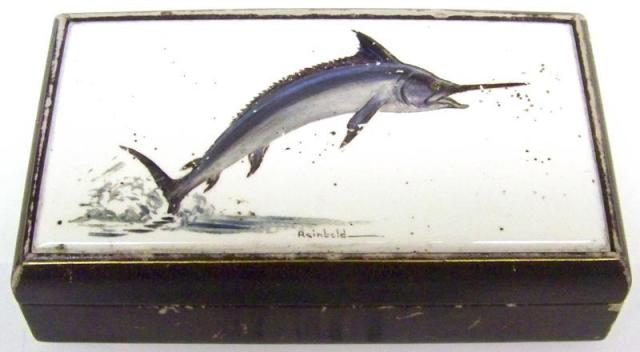 ALT
ALTThis box was sent to President Roosevelt by J. E. Ankus on June 23, 1941. Ankus was the parent of a polio patient admitted to the Warm Springs, Georgia, polio rehabilitation center established by FDR.
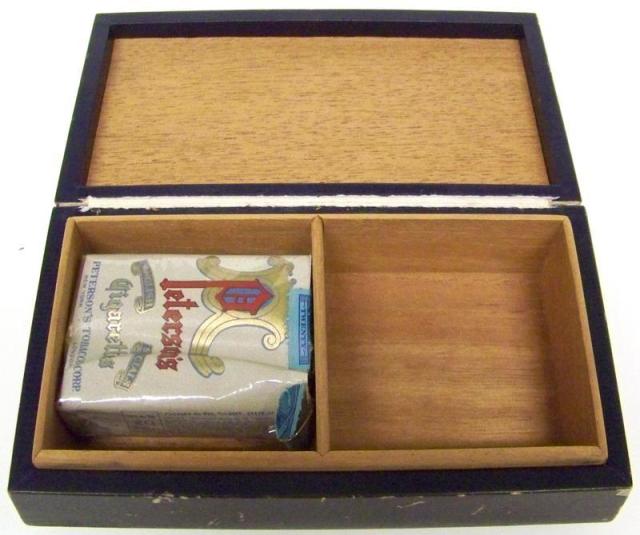 ALT
ALTFind out more about this #ArtifactRoadTrip cigarette box on our Digital Artifact Collection: https://fdr.artifacts.archives.gov/objects/29709
Follow along each week as we feature a different artifact in our Museum Collection from each of the United States.

Previously unseen home movie footage of FDR’s adapted walk
Franklin D. Roosevelt was paralyzed by polio at the age of 39. He devised a method of “walking” where he used a cane and the arm of a companion for balance. During his Presidency, the press was told not to film his disability. The FDR Presidential Library recently received footage of the 1935 White House Easter Egg Roll from a family in Nevada. Historian Geoffrey C. Ward believes it’s “the most vivid glimpse we’ve yet had” of FDR’s adapted walk. Find out the story behind the rare film.
-from@fdrlibrary
ThePare Lorentz Film Center at the Franklin D. Roosevelt Presidential Library and Museumhaslaunched a new animated video on Franklin D. Roosevelt and the Dust Bowl created by Roosevelt great-granddaughter and visual storyteller Perrin Ireland and narrated by CBS News correspondent Bill Whitaker. The project was funded by a grant from the New York Community Trust.
“FDR and the Dust Bowl” combines powerful animated visuals with stirring narrative to stimulate viewer engagement with important aspects of the Roosevelt story. This is the second video released as part of the Pare Lorentz Film Center’s “Animate the Roosevelts” project. The first video – focusing on Japanese American Interment – was released in 2017.
Read more about “FDR and the Dust Bowl” in FDR Library Director Paul Sparrow’s blog: https://fdr.blogs.archives.gov/2018/06/20/fdr-and-the-dust-bowl/
Today in history – FDR Approves the National Archives Act
On June 19, 1934, President Franklin D. Roosevelt signed “An Act to establish a National Archives of the United States Government, and for other purposes.” Read more
Photo: An image of the construction of the National Archives Building is from June 1934, the month that President Franklin D. Roosevelt signed into law the National Archives Act.
Happy Birthday to Us!
Post link
The First Lady (2022) Official Trailer | SHOWTIME
A revelatory reframing of American leadership through the lens of the First Ladies. Starring Viola Davis as Michelle Obama, Michelle Pfeiffer as Betty Ford and Gillian Anderson as Eleanor Roosevelt, this series delves deep into the Ladies’ personal and political lives. Exploring everything from their journeys to Washington, family life, and world-changing political contributions, the impact of the White House’s women is no longer hidden from view. Starring Viola Davis as Michelle Obama, Michelle Pfeiffer as Betty Ford and Gillian Anderson as Eleanor Roosevelt.
Watch the premiere on Sunday, April 17 on SHOWTIME.

